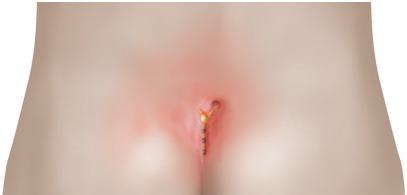What is a pilonidal sinus?
A pilonidal sinus is a problem in your natal cleft (area between your buttocks). Hairs can grow in your natal cleft, or loose hairs can fall and collect in your natal cleft. Hairs carry bacteria, which can cause inflammation and infection. An abscess can form or the pus can drain through a tunnel (sinus) out to your skin (see figure 1).
What are the benefits of surgery?
Surgery is the most dependable way to remove the pilonidal sinus and pockets of infection.
Are there any alternatives to surgery?
Washing your natal cleft every day may help to prevent an infection. An occasional discharge can be treated with antibiotics. It is sometimes possible to have a procedure to drain an abscess.
What does the operation involve?
The operation is performed under a general anaesthetic and usually takes about 30 minutes.Your surgeon will remove the sinus and infected tissue.
What complications can happen?
1. General complications
- Pain
- Bleeding
- Unsightly scarring
- Blood clots
2. Specific complications
- Partial breakdown of your wound
- Slow healing
- Numbness around your wound
How soon will I recover?
You should be able to go home the same day.
You should be able to return to work after two to three weeks.
Regular exercise should help you to return to normal activities as soon as possible. Before you start exercising, ask the healthcare team or your GP for advice.
The pilonidal sinus can come back.
Summary
Pilonidal sinus is a common problem in young adults and is best treated by surgery. It can cause an abscess or continued discharge.
Acknowledgements
Author: Prof Simon Parsons DM FRCS (Gen. Surg.) Illustrations: Medical Illustration Copyright © Medical-Artist.com
This document is intended for information purposes only and should not replace advice that your relevant health professional would give you.
